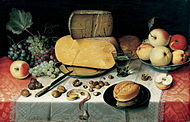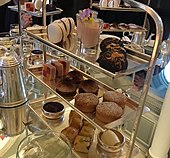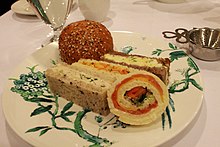Tea (meal)

| Part of a series on |
| Meals |
|---|
 |
| Meals |
| Components and courses |
| Related concepts |
Tea is an umbrella term for several different meals consisting of food accompanied by tea to drink. The English writer Isabella Beeton, whose books on home economics were widely read in the 19th century, describes meals of various kinds and provides menus for the "old-fashioned tea", the "at-home tea", the "family tea", and the "high tea".[1]
Teatime is the time at which this meal is usually eaten, which is mid-afternoon to early evening.[2] Tea as a meal is associated with the United Kingdom and some Commonwealth countries. Some people in Britain and Australasia refer to their main evening meal as "tea" rather than "dinner" or "supper", the use of "tea" differs based on social class, "tea" can refer to a light meal or a snack.[citation needed] A tea break is the term used for a work break in either the morning or afternoon for a cup of tea or other beverage.
The most common elements of the tea meal are the drink itself, with cakes or pastries (especially scones), bread and jam, and perhaps sandwiches; these are the pillars of the "traditional afternoon tea" meals offered by expensive London hotels.[3] Other types of both drink and food may be offered at home.
History
[edit]
The timing of the "tea" meal has moved over the centuries in response to the migration of the main meal, dinner. Until the late 18th century dinner was eaten at what is now called "lunchtime", or in the early afternoon; supper was a later and lighter meal. Dinner remains a midday meal in some regions. Gradually, dinner began to migrate, amid much controversy, until by about 1900 it arrived at its present timing, in most places, in the evening. At first, the "tea" meal was often in the early evening, some three or four hours after mid-day dinner; another version of the tea meal was even later, after a supper and before bed.[4]
In 1804 Alexandre Balthazar Laurent Grimod de La Reynière wrote (in French) about afternoon tea in Switzerland:
Towards five o'clock in the evening, the mistress of the house, in the midst of the sitting-room, makes tea herself, very strong and barely sweetened with a few drops of rich cream; generous slices of buttered bread accompany it. Such is the Swiss Tea in all its simplicity. In most opulent houses, however, coffee and light pastries of all kinds are added, many of which are unknown in Paris, preserved or candied fruits, macaroons, biscuits, nougat, and even ice cream.[5]: 54
Observance of the custom originated amongst the wealthy social classes in England in the 1840s.[6] The ritual was invented by the seventh Duchess of Bedford, Anna Maria Russell, one of Queen Victoria's ladies-in-waiting, in around 1840. Due to increasing urbanisation and industrialisation, wealthy English people were having their evening meal later and later, but still eating lunch at midday. The Duchess became despondent at the void between the two meals, and its consequent 'sinking feeling'. She therefore asked that some tea, bread and butter and cake be delivered to her room late in the afternoon, and "an afternoon ritual was born".[7]
The Oxford English Dictionary provides citations dating back a century before this, in reference to tea as a social gathering. The earliest is from Jonathan Swift's satirical etiquette guide, A Complete Collection of Genteel and Ingenious Conversation (1738), "Whether they meet..at Meals, Tea, or Visits". John Wesley and Harriet Martineau also are quoted.[8] Philosopher Thomas Carlyle and his wife Jane Welsh Carlyle invited guests for 7 pm to their teas in the 1850s, although "afternoon tea" before dinner was also becoming established by this time.[9]
After inventing the ritual of afternoon tea, the Duchess of Bedford started inviting her friends to join in. As those friends were also royal courtiers, Queen Victoria became aware of the nascent custom, and immediately approved. By the 1880s, her Majesty had adopted the ritual herself, and was holding official tea receptions at her palaces.[10]
As of the end of the 19th century, afternoon tea had developed into its current form and was being taken by both the upper and middle classes. It became ubiquitous, even in the isolated village in the fictionalised memoir Lark Rise to Candleford, where a cottager prepares what she calls a "visitor's tea" for their landlady: "the table was laid... there were the best tea things with a fat pink rose on the side of each cup; hearts of lettuce, thin bread and butter, and the crisp little cakes that had been baked in readiness that morning."[11]
Commercial establishments known as teahouses or tearooms (similar to a coffeehouse) were once common in the UK, but they have declined in popularity since World War II. A.B.C. tea shops and Lyons Corner Houses were successful chains of such establishments, and played a role in opening up possibilities for Victorian women. A list of significant tea houses in Britain gives more examples. They served light snacks or full meals all day, some of them late into the evening. They were well-lit and did not serve alcohol.
Afternoon tea
[edit]

Afternoon tea is a light meal typically eaten between 3:30 pm and 5 pm. Traditionally it consisted of thinly-sliced bread and butter, delicate sandwiches (customarily cucumber sandwiches or egg and cress sandwiches) and usually cakes and pastries (such as Battenberg cake or Victoria sponge). Scones (with clotted cream and jam) would also be served (as they are for cream tea). The sandwiches are usually crustless, cut into small segments, either as triangles or fingers, and pressed thin. Biscuits are not usually served.
Nowadays, a formal afternoon tea is more of a special occasion, taken as a treat in a hotel. The food is often served on a tiered stand ('serving tower'); there may be no sandwiches, but bread or scones with butter and jam, or toast, muffins or crumpets.[12][13][14]
Formal afternoon tea remains a popular tradition in the Commonwealth, particularly at fine hotels.[10] In London, the major hotels compete for the annual Afternoon Tea Awards.[15] In Canada, afternoon tea ceremonies at the grand railway hotels are a well-known tradition across the country.[10] In Australia, venues nationwide ranging from the Hotel Windsor in Melbourne, which first served high tea in 1883, to hotels opened in the 21st century serve a variety of afternoon teas, including traditional, modern, and novel, sometimes with items flavoured using local ingredients.[16][17] In the United States, the "afternoon tea industry" is also primarily the province of destination hotels.[18][19]

Cream tea
[edit]
This snack, often a form of or part of afternoon tea, is associated with the West Country, i.e. Cornwall, Devon, Dorset and Somerset. It usually consists of scones, clotted cream, strawberry jam, and tea to drink. Some venues will provide butter instead of clotted cream. In Australia, this is commonly referred to as Devonshire Tea.
High tea
[edit]High tea is a late afternoon or early evening meal, sometimes associated with the working class, farming, and eating after sports matches. It is typically eaten between 5 pm and 7 pm. It was also sometimes called a "meat-tea" in the past.[20]
In some parts of the United Kingdom (namely, the North of England, North and South Wales, Scotland, and some rural and working class areas of Northern Ireland), people traditionally call their midday meal dinner and their evening meal tea (served around 6 pm), whereas elsewhere people would call the midday meal lunch or luncheon and the evening meal (served after 7 pm) dinner (if formal) or supper (if informal).[21]
High tea typically consists of a savoury dish (either something hot, or cold cuts of meat such as ham salad), followed by cakes and bread, butter and jam, all accompanied by tea.[22] In The Cambridge Social History of Britain, 1750–1950, high tea is defined thus:
the central feature was the extension of a meal based predominantly on bread, butter and tea by the inclusion of some kind of fish or meat usually cooked in a frying pan.[23]
A stereotypical expression "You'll have had your tea", meaning "I imagine you have already eaten", is used to parody people from Edinburgh as being rather stingy with hospitality.[24] A BBC Radio 4 comedy series of this name was made by Graeme Garden and Barry Cryer.
Australian, South African and New Zealand
[edit]In South Africa, New Zealand, and Australia, a small informal social gathering usually at someone's home for tea and a light meal (e.g. biscuits, scones, or slices of cake or sandwiches) in the mid-afternoon is referred to as "afternoon tea". More generally, any light meal or snack taken at mid-afternoon, with or without tea or another hot drink, may also be referred to as "afternoon tea". When taken at mid-morning instead of mid-afternoon, the term "morning tea" is used in place of "afternoon tea" in Australia and New Zealand. These usages have declined in popularity in recent years, in tandem with the rise in coffee culture, particularly in Australia.[25] The term high tea is now used in the southern hemisphere to describe formal afternoon teas. Formal afternoon teas are often held outside the private home in commercial tea rooms, function venues, hotels, or similar.[26]
In Australia and New Zealand, a break from work or school taken at mid-morning is frequently known as "morning tea", and a break at mid-afternoon as "afternoon tea," both with or without the tea being drunk. A smoko, originally meaning a cigarette break, is also used as slang for a break, especially for people working in manual work.
In Australia and New Zealand, tea also refers to "dinner".[27][28]
See also
[edit]- History of tea
- Merienda, the Hispanic analogue
- Tea culture
- Tea dance
- Tea in the United Kingdom
- Tea lady, an employee in a hospital or place of work
- Tea set, the tea pot, sugar bowl, milk jug, etc.
- Tiffin
- Elevenses
- Palm court, a room in a hotel where tea dances took place
References
[edit]- ^ Beeton, Isabella (1898). "Tea". Mrs Beeton's Cookery Book and Household Guide (New and Greatly Enlarged ed.). London: Ward, Lock & Co., Ltd. pp. 263–264. Retrieved 13 March 2019 – via Google Books.
- ^ Copeman, Dawn (2006). "It's Time for Tea". Time Travel Britain. Retrieved 13 March 2019.
- ^ "Teas at the Ritz Hotel, London". Archived from the original on 9 June 2019. Retrieved 9 June 2019.
- ^ Ayto, John (2012). The Diner's Dictionary (2nd ed.). Oxford University Press. ISBN 978-0-19-964024-9.
Tea seems first to have established for itself a particular niche in the day in the 1740s, by which time it had become the fashionable breakfast drink. It was also drunk after dinner, and as the usual time for dinner progressed during the 18th century towards the evening, a gap opened up for a late-afternoon refreshment, filled by what has since become the traditional English afternoon tea, a meal in its own right, with sandwiches and cake as well as cups of tea (amongst the earliest references to it are these by Fanny Burney in Evelina, 1778: "I was relieved by a summons to tea," and by John Wesley in 1789: "At breakfast and at tea... I met all the Society"; Anna Maria Russell, Duchess of Bedford (1783–1857), famously claimed to have originated the fashion, but it was in existence well before she was in a position to have any influence over it). In various other parts of the English-speaking world, teatime has assumed other connotations: in Jamaica it is the first meal of the day, while for Australians and New Zealanders it is a cooked evening meal – a usage reflected in the tea, and more specifically the "high tea", of certain British dialects, predominantly those of the working class and of the North (the term high tea dates from the early 19th century).
- ^ Grimod de La Reynière, Alexandre-Balthazar-Laurent (1804). Almanach des Gourmands, Seconde Année. Paris: Maradan. Retrieved 5 August 2021.
- ^ p. 209, Pool, Daniel (1993) "What Jane Austen Ate and Charles Dickens Knew", Touchstone/Simon & Schuster, New York
- ^ Marks, Tasha (14 August 2020). "The tea-rific history of Victorian afternoon tea | British Museum". British Museum. Retrieved 30 December 2023.
- ^ "Home : Oxford English Dictionary". www.oed.com. Retrieved 15 January 2022.
- ^ Flanders, 229-231
- ^ a b c Parker, Catherine (8 April 2019). "6 Places to Take Afternoon Tea Across Canada". Wander with Wonder. THOT Information Services LLC. Retrieved 11 March 2022.
- ^ Pettigrew, Jane (2001). A Social History of Tea. London: The National Trust. pp. 102–5.
- ^ Mason, Laura; Brown, Catherine (1999), From Bath Chaps to Bara Brith, Totnes: Prospect Books.
- ^ Pettigrew, Jane (2004), Afternoon Tea, Andover: Jarrold.
- ^ Fitzgibbon, Theodora (1972), A Taste of England: The West Country, London: JM Dent.
- ^ Guy, Sandy (14 October 2023). "London's best afternoon teas". The West Australian. Retrieved 29 December 2023.
- ^ "Best high tea in Australia: 17 places to try this weekend". delicious.com.au. Retrieved 29 December 2023.
- ^ Grossetti, Carla (29 March 2022). "The best high teas in hotels around Australia". Australian Traveller. Retrieved 29 December 2023.
- ^ DestinationTea (6 January 2022). "The United States of Afternoon Tea, 2021 Snapshot". Destination Tea. Retrieved 20 January 2024.
- ^ Chang, Katie (17 April 2017). "The 12 Best Spots Across the Country For Afternoon Tea". Town & Country. Retrieved 20 January 2024.
- ^ Flanders, 231
- ^ "Tea with Grayson Perry. Or is it dinner, or supper?". The Guardian. London. August 2012. Retrieved 15 August 2013.
- ^ "What's the Difference Between High Tea and Afternoon Tea?". The Spruce Eats. Retrieved 10 March 2022.
- ^ Thompson, FML; Oddy, Derek J. (1990). "5". The Cambridge Social History of Britain, 1750-1950. CUP. p. 260.
- ^ Morton, Brian (26 April 2013). "On Glasgow and Edinburgh, By Robert Crawford". The Independent. Archived from the original on 26 May 2022. Retrieved 25 January 2017.
- ^ Whitehead, RJ. "Subscribe to our FREE newsletter Your e-mail address Subscribe Hot drinks down under: Australia's coffee culture booms, but tea could do with a lift". Food Navigator Asia. William Reed Limited. Retrieved 11 March 2022.
- ^ "It's love in the afternoon as Australians lap up 'high' tea". The Age. Retrieved 6 January 2015.
- ^ "Australian Slang For Dinner (Explained!)". Foreign Lingo. 9 September 2024. Retrieved 9 September 2024.
- ^ "Do you speak Kiwinglish? New Zealand's distinct linguistic identity". The Guardian. 10 March 2015. ISSN 0261-3077. Retrieved 27 February 2024.
Further reading
[edit]- Flanders, Judith, The Victorian House: Domestic Life from Childbirth to Deathbed, 2003, Harper Perennial, ISBN 0007131895
- Post, Emily (1922). "Chapter XIII: Teas and Other Afternoon Parties". Etiquette.